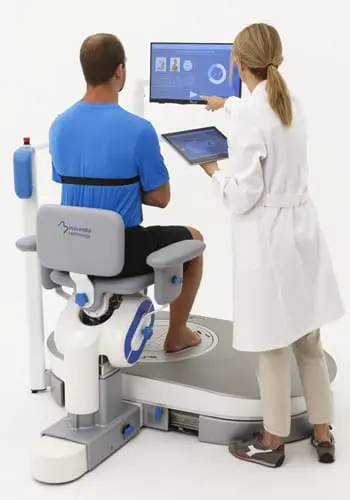Therapeutic Technology
Our hospital provides such leading-edge technology – as well as therapists trained to use it best – to ensure our patients are positioned to recover as quickly as possible.
Innovative Solutions for Superior Outcomes
New technology continues to push the boundaries of what once was considered full recovery from certain injuries or conditions. Today, for instance, top inpatient rehabilitation facilities deploy robotic tools that give stroke patients the ability to use their upper extremities again or help spinal cord injury patients with early ambulation.
Our hospital provides such leading-edge technology – as well as therapists trained to use it best – to ensure our patients are positioned to recover as quickly as possible.
Here are some examples of some of the industry’s best technology deployed at our hospital:
TecnoBody® Isofree
The TecnoBody® Isofree system was designed to treat anyone looking to improve balance, stability, and functional mobility. It addresses a wide variety of pathologies and is a good tool to use in conjunction with traditional therapeutic interventions. TecnoBody Isofree allows for enhancing kinesthetic and proprioceptive awareness during functional tasks as well as working on improving reflex mechanisms that play a role in maintaining balance and decreasing the risk of falls. All of this is facilitated via biofeedback that is provided throughout the activity by the interconnected sensor platform and 3D camera.
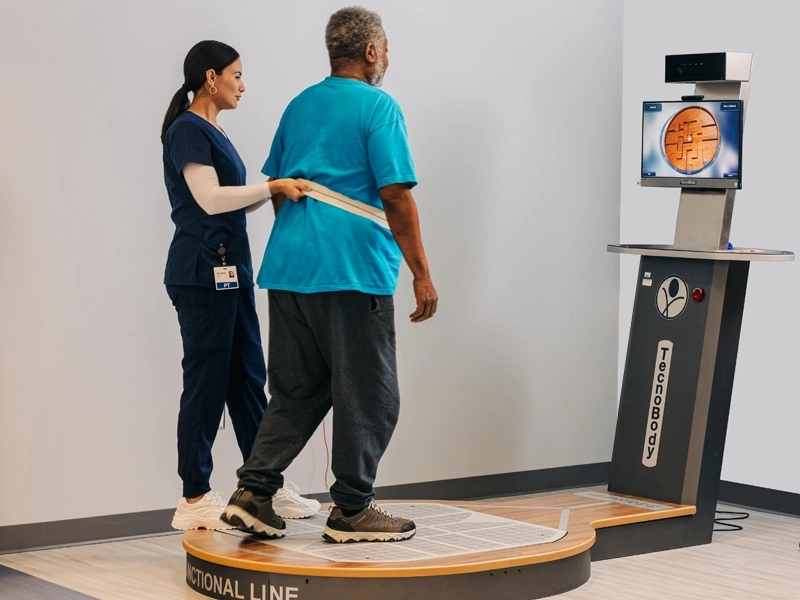
Smart Car
Our Smart Car is fully integrated into our rehab gym, allowing our patients to learn and practice car transfer skills year-round at any time during a treatment session. Car transfer training activities are essential to prepare our patients for community reintegration and setting them up for success when getting back to their daily activities.
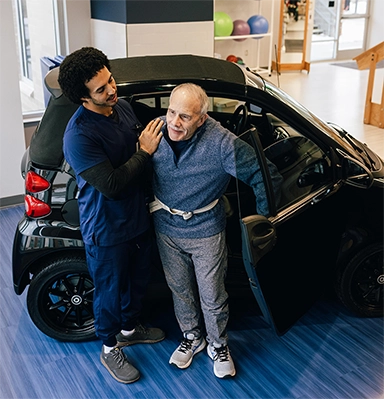
LiteGait®
LiteGait® is a body-weight support system and gait training device that provides a safe environment for patients to participate in gait training over a treadmill or over the ground. This system allows patients to begin gait training earlier in the rehabilitation process and at a lower level than would be feasible with any other assistive device available. The LiteGait system eliminates the fear of falling and/or loss of balance with standing and walking tasks and allows the therapist the ability to provide manual assistance to the legs and pelvis throughout the gait cycle to facilitate proper gait patterns.
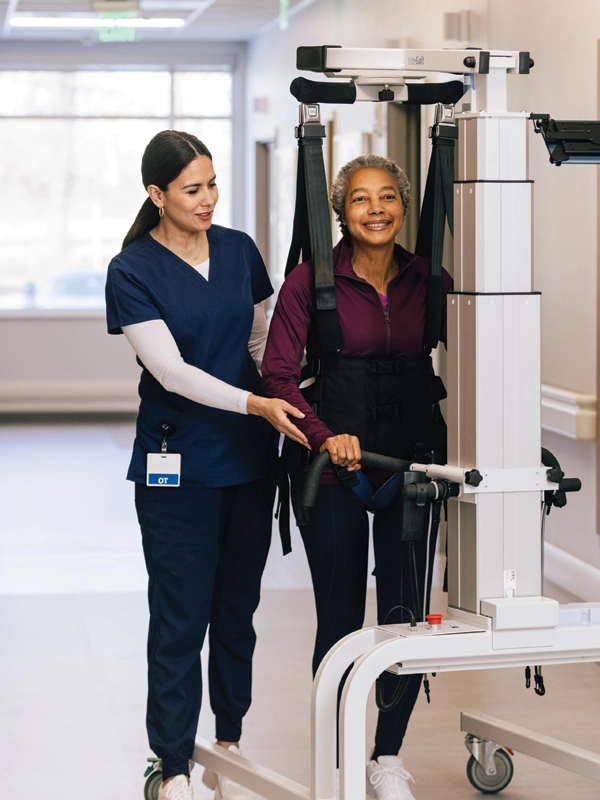
Varied Surface Gait Training
An outdoor gait training courtyard is available for patients to practice walking on multiple surfaces (concrete, grass, gravel, stairs, inclines, declines, etc.). This provides the treatment team opportunities to simulate the environments that most closely resemble the challenges the patient will face when discharged home.
Overhead Body Weight Support System
Our overhead body weight support system provides dynamic body weight support while patients practice walking, balance tasks, sit-to-stand transfers, open and closed-chain strengthening exercises, and even steps. This system is mounted to an overhead track, allowing for use within the parallel bars or outside of the bars when introducing an assistive device during gait training progression. The body weight support system provides a safe environment for patients to begin standing, transfer, and gait training.
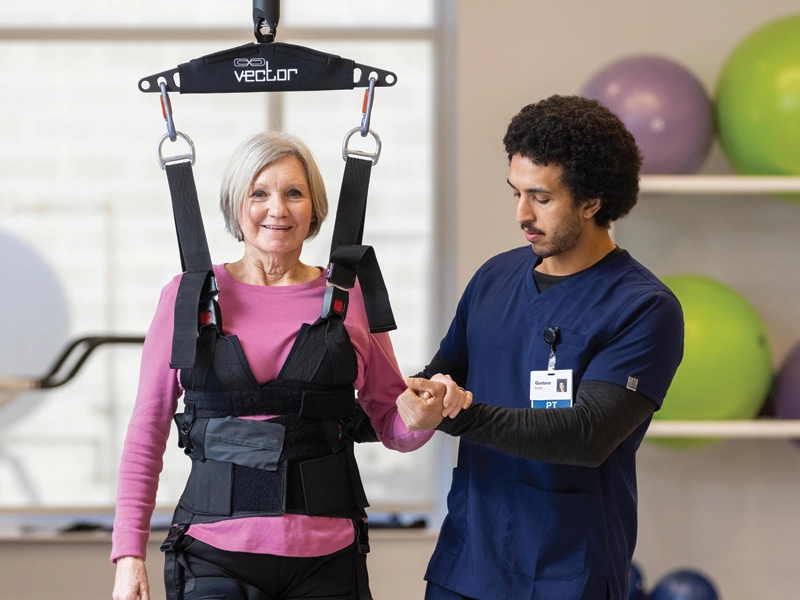
SaeboMAS
The SaeboMAS is a zero-gravity upper extremity device used to facilitate or challenge the weakened shoulder during functional tasks, such as eating or combing your hair. This device is used with patients with neurological and orthopedic conditions resulting in shoulder weakness. The adjustable spring-based tension system offers variable levels of assistance as the patient’s strength improves and makes it easy to track and document progress. It can be used to increase strength, range of motion, and motor control and encourage neuroplasticity by allowing the opportunity for highly repetitive tasks.
InMotion
The BIONIK InMotionARM™ Robot is often used with many patients who suffer from weakness in their upper extremities after a stroke. The ARM Robot helps patients utilize their strength to complete hundreds of repetitions in a fraction of the time of traditional exercise. Repetition is one of the most important factors when considering neuroplasticity and the brain’s ability to repair and relearn movements following a stroke. This evidence-based neurorehabilitation technology quietly monitors the patient’s movements during therapy while gently assisting where needed to help them complete various motor therapy activities.
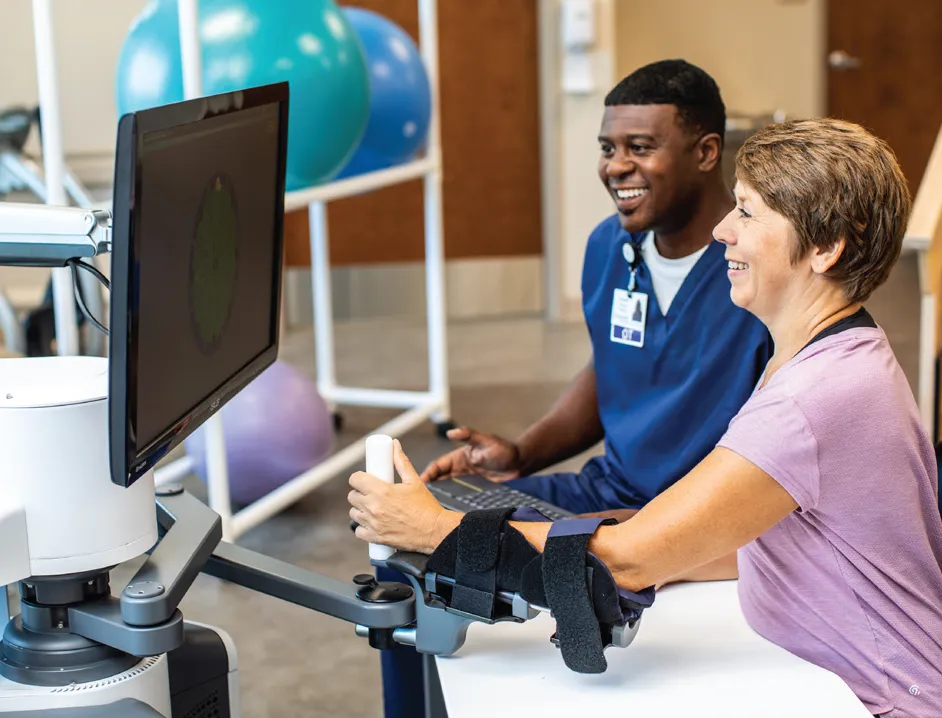
EksoGTTM
The EksoGT™ exoskeletal unit assists patients with early ambulation following a stroke or spinal cord injury. Ekso is a robotic exoskeleton that can be fitted to most patients to allow them to stand and ambulate early in the rehab process, which is key to their long-term prognosis. Clinical evidence indicates that gait training in the Ekso improves patients’ balance, walking distance, and gait speed outside of the device at discharge compared to admission.
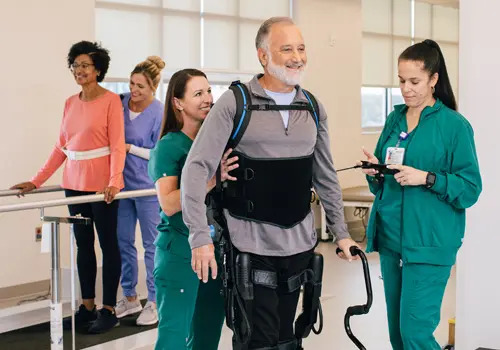
RehabTracker
RehabTracker is a groundbreaking person-centered mobile app that is transforming how our partners engage with patients and their families. Combined with our approach of focusing our care around What Matters to You (the patient), RehabTracker allows patients and their invited loved ones to view their personalized goals, see and track their patient progress in real-time as logged by our therapists, including overall progress toward discharge goals, activities of daily living, distance and transfers, share that progress with invited family and friends, share patient photos during their recovery journey, receive comments from staff and messages of support from loved ones – all from the palm of their hands. Areas of patient progress include self-care activities such as bathing, dressing, and eating, mobility activities including walking, transfers, and bed mobility, speech-language activities including expression and comprehension, memory and problem-solving, and diet/swallowing food and liquid consistencies. Facilities utilizing RehabTracker have experienced greater levels of patient motivation as well as patient and family member engagement and satisfaction.
Low Stimulation Gym
Patients who have experienced a stroke or brain injury can sometimes become overwhelmed in noisy, bright, or busy environments. This “over-stimulation” can negatively affect the patient’s ability to participate in the therapy program and slow recovery. Our rehabilitation facility offers a separate low-stimulation therapy gym for these patients to provide the optimal healing experience.
ESP: Effective Swallowing Protocol
ESP is a non-invasive, FDA-cleared treatment for dysphagia that combines the most effective electrical stimulation parameters with resistive exercises.
It includes Ampcare's E Series electrodes that elicit the most comfortable motor contractions by stimulating inactive or atrophied swallowing muscles via the portable powered muscle Stimulator with adjustable parameters and the Restorative Posture Device as an extrinsic resistive exercise.
The result is improved quality of muscle contraction and swallowing function.
How Does ESP Work?
Combining neuromuscular electrical stimulation with resistive swallowing exercises and postural strategies using the Restorative Posture Device (RPD), ESP works by achieving the following:
- Movement of the airway out of the food’s pathway
- Stimulation of fast-twitch, powerful muscle fibers to elicit motor contraction
- A 30-minute treatment time, providing 60, 72, or up to 90 swallowing attempts
- A safe, effortful swallow
- Decreased risk for aspiration
LSVT® BIG and LOUD Therapy
Now providing treatment for Parkinson’s disease and other neurological conditions.
Lee Silverman Voice Treatment (LSVT®) Big and Loud Therapy to empower those living with Parkinson's disease to move and speak better. Declining vocal strength, muffled speech and difficulty swallowing create problems with communication and eating. Patients also often experience tremors, slow movement, impaired balance and stiffness. But there is good news – studies have proven patients with Parkinson's disease at any stage can benefit from intensive rehabilitation.
- LSVT® can help people with other conditions such as stroke, multiple sclerosis, multiple systems atrophy, cerebral palsy.
- LSVT® Big and Loud is especially effective soon after the disease is diagnosed.
SPEAK LOUD – MOVE BIG: LSVT® is an effective treatment program that's proven to help individuals living with Parkinson's disease, giving them new hope for improved communication and movement for work, family and social activities. The method was developed following rigorous research funded by the National Institutes of Health.
LSVT BIG™: Physical therapists or occupational therapists use LSVT Big to address the unique movement impairments for people with Parkinson's disease. Therapists work with individuals to improve major motor skills, like walking, arm and leg movement, balance, and hand skills such as writing.
LSVT LOUD™: Speech-language pathologists improve vocal loudness by stimulating the muscles of the voice box (larynx) and speech mechanism through a series of loud exercises. Therapy does not train people to shout or yell – rather it trains a healthy louder voice with no strain.
Movendo Hunova
Nearly 8 million U.S. adults, including almost 40 percent of older Americans, have trouble with balance. In addition to the elderly, people with neurological conditions such as multiple sclerosis and Parkinson's and those who have suffered a stroke also experience balance issues. These problems with balance frequently lead to falls and negatively affect quality of life.
Methodist Rehabilitation Hospital, a leader in physical therapy for all medical conditions, is currently the only hospital in Dallas, Texas, offering a new robotic rehabilitation system for objectively evaluating balance problems and a range of exercises to improve the condition.
The hunova is a programmable robotic medical device dedicated to rehabilitation for orthopedic, neurologic, and geriatric patients. It can be used standing or sitting and provides 200 evaluations and exercises for postural control, stretching, muscle strengthening, balance, and core stability. It has two sensitive force plates, which gives it the unique ability to predict and prevent the risk of falls, highlighting specific deficiencies and providing personalized rehabilitative intervention.
For patients with neurological problems, the hunova helps with post-stroke functional re-education and in the treatment of degenerative diseases of the central nervous system and the peripheral nervous system.
The hunova is also extremely effective in helping rehabilitate the ankle, knee, hip, and lumbar region of the spine after orthopedic injuries.
